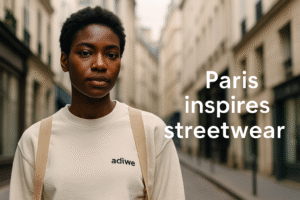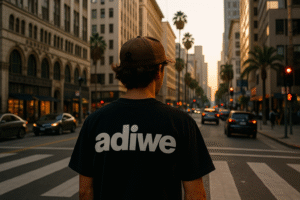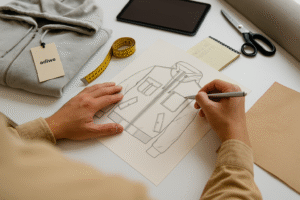Wondering about the real distinctions between customizing streetwear and high fashion? It's easy to get them mixed up. Understanding these differences is crucial for your brand's direction and appeal.
Streetwear customization focuses on accessible self-expression, often using prints and ready-made garments. High fashion customization emphasizes bespoke tailoring, rare materials, and exclusive, one-of-a-kind artisanal creations for a select clientele.
The world of fashion customization is diverse, and not all "custom" is created equal. As a B2B manufacturer at Adiwe, working with streetwear brands, KOLs, and trendsetters daily, I've seen firsthand how these distinctions play out. We specialize in top-quality, personalized designs for items like t-shirts and hoodies, catering to clients who want very trendy, customizable pieces. When a client like Fifty Fifty from England, who focuses on design and quality for their hoodies, talks about customization, their needs are distinct from what a couture house might offer. Understanding this helps us, as their manufacturing partner in China, deliver exactly what they and their youthful audience are looking for. Let's explore these differences.
Is the Core Philosophy of Customization the Same Across Both Worlds?
You might think customization is just about making something unique, right? But the 'why' and 'how' differ hugely. This impacts everything from design to who it's for.
No, the core philosophy isn't the same. Streetwear customization champions democratic self-expression and identity. High fashion customization, conversely, is rooted in exclusivity, unparalleled craftsmanship, and personal luxury for a discerning few.
!
The fundamental approach to customization in streetwear versus high fashion stems from very different origins and serves different purposes. Streetwear's customization roots are often in DIY culture, subcultures, and making a personal statement. It's about taking something, often an accessible base item like a t-shirt or hoodie, and making it uniquely yours through graphics, alterations, or embellishments. I see this with many trend brands we supply; they want their clothing, even when produced in wholesale quantities, to offer a canvas for individual expression. Our ability at Adiwe to offer customizable fabrics, logos, and intricate craftsmanship allows these brands to build that foundation for their customers. High fashion, on the other hand, views customization through the lens of haute couture – the pinnacle of artistry and exclusivity. It's about a client commissioning a unique piece, perfectly tailored, often involving many hours of handwork by skilled artisans.
Diving Deeper into the Underlying Ethos
The ethos behind customization shapes the entire process, from initial concept to the final wearer.
| Feature | Streetwear Customization Ethos | High Fashion Customization Ethos | Adiwe's Connection (Streetwear Focus) |
|---|---|---|---|
| Accessibility | High; often built on affordable base items. | Low; very exclusive, high price point. | We provide quality bases for accessible customization. |
| Goal | Self-expression, identity, trend relevance, community. | Perfect fit, unique luxury, status symbol, artistic creation. | Our personalized designs help brands build identity. |
| Inspiration | Subcultures, music, art, current trends, DIY. | Master craftsmanship, historical references, artistic vision. | We help produce very trendy items reflecting current vibes. |
| Audience | Broad, youth-oriented, community-driven. | Wealthy individuals, collectors, red carpet. | Our clients target trend-conscious young people. |
Streetwear customization thrives on individuality within a collective. Think about band t-shirts customized with patches, or hoodies with unique screen prints that resonate with a particular subculture. It's about being part of a movement but still showcasing your personal spin. At Adiwe, when we produce customizable hoodies or t-shirts, we understand they become tools for this expression.
High fashion customization, like a bespoke suit or a couture gown, is about the ultimate personal luxury and a direct relationship with the designer or atelier. The goal is often an heirloom piece, a work of art tailored to one individual. The exclusivity is a major part of the appeal.
How Do the Design and Production Processes Actually Compare?
Is customizing a hoodie just like commissioning a bespoke gown, but simpler? Not really. The journey from idea to finished product is vastly different, impacting time, cost, and skill.
Streetwear customization often involves graphic applications, embellishments, or modifying existing garment blanks. High fashion involves creating bespoke patterns, meticulous hand-crafting, multiple fittings, and often, highly specialized artisanal techniques from scratch.

The practical steps involved in customizing streetwear versus high fashion highlight their distinct natures. When a streetwear brand, perhaps one of our clients from North America or France, wants a custom run of t-shirts, the process might involve selecting one of our top-quality base garments, then working with our team on unique graphic designs, custom dye treatments, or specific logo applications. We have 5 production lines ready to handle these kinds of requests, ensuring we can reproduce complex designs accurately, which is a pain point for clients like Fifty Fifty. Our focus is on delivering a trendy, personalized product efficiently and at a quality that reflects well on their brand. This might involve specialized printing techniques, custom labeling, or unique accessories, but it generally builds upon established silhouettes.
High fashion customization is a far more intensive and lengthy affair. It typically starts with a personal consultation with the couturier, followed by the creation of a unique pattern for the client. Muslin toiles (mock-ups) are made, and multiple fittings are required to ensure a perfect fit.
Deep Dive into Design and Production Workflows
Understanding the workflow differences is key for brands deciding which path aligns with their vision and resources.
| Aspect | Streetwear Customization Process | High Fashion Customization Process | Adiwe's B2B Streetwear Focus |
|---|---|---|---|
| Starting Point | Often existing blanks/styles; focus on surface/details. | Usually from scratch; bespoke pattern drafting. | We offer diverse, high-quality blanks ready for personalization. |
| Design Input | Brand's aesthetic, graphic design, trend adaptation. | Client's desires, designer's artistic vision, body measurements. | We collaborate on personalized designs and complex styles. |
| Craftsmanship | Quality printing, embroidery, specialized washes, assembly. | Hand sewing, intricate embellishments, perfect tailoring. | Our expertise lies in top-quality craftsmanship for streetwear. |
| Lead Time | Relatively shorter; weeks to a couple of months. | Very long; months, sometimes over a year. | We manage efficient production for wholesale orders. |
| Fittings | Minimal or none for bulk customization; samples approved. | Multiple, essential for bespoke fit. | We provide samples for approval before mass production. |
For streetwear, especially in a B2B context like ours at Adiwe, customization might mean a client wants a specific Pantone color for their fabric, a unique distressed wash on denim, or a complex, multi-layered screen print for a hoodie. The core garment structure might be standard, but the details make it unique to their brand. We use our factory's capabilities to achieve these personalized design elements, from custom fabric sourcing to intricate logo applications and accessories.
For high fashion, think of a wedding dress or a red-carpet gown. The couturier might spend hundreds of hours, with a team of artisans, on a single garment. Each seam, each bead, each piece of embroidery is meticulously planned and executed by hand. This level of detail and personal attention is what defines haute couture customization.
What About the Materials and Techniques Used in Each Customization Type?
Do both streetwear and high fashion use the same fancy fabrics and methods when customizing? The choice of materials and techniques often defines the final product and its purpose.
Streetwear customization typically utilizes durable, versatile, and printable fabrics like cotton, denim, and blends, with techniques focused on surface design. High fashion employs rare, luxurious materials and intricate, often manual, artisanal techniques.

The materials and techniques are a direct reflection of each sector's philosophy. In streetwear, practicality, comfort, and the ability to hold prints or embellishments are key. For the t-shirts and hoodies we produce at Adiwe, clients often request robust cottons, soft fleece, or performance blends that feel good, wear well, and serve as an excellent canvas for their personalized designs. Techniques might include advanced screen printing, digital printing (DTG), embroidery, appliqué, custom washes, or distressing. The goal is a top-quality, trendy garment that can withstand daily life while showcasing a unique design. Our clients, including KOLs and established clothing brands, rely on us to source customizable fabrics that meet these needs and to apply craftsmanship that makes their logos and designs pop.
High fashion customization, however, ventures into the realm of the exquisite and often, the delicate. Think fine silks, Chantilly lace, hand-loomed cashmere, exotic leathers, or fabrics woven with precious metal threads.
Diving Deeper into Material and Technical Distinctions
The choice of materials and the techniques applied are fundamental to the identity of the customized piece.
| Aspect | Streetwear Customization Materials & Techniques | High Fashion Customization Materials & Techniques | Adiwe's Streetwear Manufacturing Edge |
|---|---|---|---|
| Primary Fabrics | Cotton, jersey, fleece, denim, polyester blends, nylon. | Silk, satin, chiffon, velvet, cashmere, fine wools, lace. | We source top-quality, customizable fabrics ideal for streetwear. |
| Embellishments | Screen prints, DTG, embroidery, patches, studs, transfers. | Hand-embroidery, beading, feather work, pleating, draping. | We excel in various printing and embroidery techniques. |
| Construction | Machine-sewn, focus on durability and comfort, serging. | Often hand-sewn finishes, intricate internal structuring. | Our 5 production lines ensure quality construction. |
| Focus | Visual impact, brand identity, wearability, trendiness. | Artistry, perfect fit, luxurious feel, timelessness. | We deliver very trendy products with excellent craftsmanship. |
For streetwear, if a brand like Fifty Fifty wants a hoodie with a complex graphic and specific ribbing, we’re looking at high-quality cotton fleece and precision printing or embroidery. The materials must be durable enough for everyday wear and also provide a good base for the customization techniques. We ensure that even with complex designs, the "top quality" is evident.
In high fashion, a designer might spend weeks sourcing a specific type of vintage lace or commissioning a hand-painted silk. Techniques like flou (dressmaking) and tailleur (tailoring) are executed with painstaking precision. The interior construction of a couture garment can be as beautiful and complex as the exterior. It's a different universe of material sourcing and application, focused on ultimate luxury rather than mass appeal or ruggedness.
Conclusion
Streetwear customization champions accessible self-expression via graphics and details. High fashion offers exclusive, bespoke artistry with rare materials. Understanding this helps brands and us at Adiwe serve our clients effectively.




